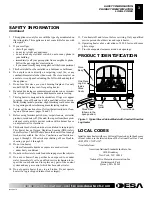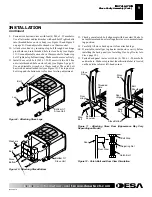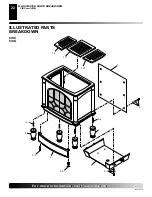
104463-01E
For more information, visit www.desatech.com
For more information, visit www.desatech.com
11
11
CAUTION: Use only new, black iron or steel pipe.
Internally-tinned copper tubing may be used in certain
areas. Check your local codes. Use pipe of 1/2" diam-
eter or greater to allow proper gas volume to heater. If
pipe is too small, undue loss of volume will occur.
Installation must include a equipment shutoff valve, union, and
plugged 1/8" NPT tap. Locate NPT tap within reach for test gauge
hook up. NPT tap must be upstream from heater (see Figure 18).
IMPORTANT:
Install equipment shutoff valve in an accessible
location. The equipment shutoff valve is for turning on or shutting
off the gas to the appliance.
Check your building codes for any special requirements for locating
equipment shutoff valve to fireplaces.
Apply pipe joint sealant lightly to male NPT threads. This will
prevent excess sealant from going into pipe. Excess sealant in pipe
could result in clogged heater valves.
WARNING: Never connect heater to private (non-
utility) gas wells. This gas is commonly known as
wellhead gas.
INSTALLATION
Continued
CONNECTING TO GAS SUPPLY
WARNING: This appliance requires a 1/2" NPT
(National Pipe Thread) inlet connection to the pres-
sure regulator.
Installation Items Needed
Before installing heater, make sure you have the items listed below.
• piping (check local codes)
• sealant (resistant to propane/LP gas)
• equipment shutoff valve *
• test gauge connection *
• sediment trap
• tee joint
• pipe wrench
* A CSA design-certified equipment shutoff valve with 1/8" NPT
tap is an acceptable alternative to test gauge connection. Purchase
the optional CSA design-certified equipment shutoff valve from
your dealer. See Accessories, page 19.
The gas inlet connection for the stove heater is located on the lower
right-hand side of the stove when viewed from the front of the unit.
The gas connection can be made either through the bottom right side
or through the lower back opening as illustrated in Figure 17. Make
sure gas log heater is secured to the stove cavity assembly.
WARNING: A qualified service person must con-
nect heater to gas supply. Follow all local codes.
Figure 18 - Gas Connection
* Purchase the optional CSA design-certified equipment shutoff
valve from your dealer. See Accessories, page 19.
** Minimum inlet pressure for purpose of input adjustment.
WARNING: Use pipe joint sealant that is resistant
to liquid petroleum (LP) gas.
We recommend that you install a sediment trap in supply line as shown
in Figure 18. Locate sediment trap where it is within reach for cleaning.
Install in piping system between fuel supply and heater. Locate
sediment trap where trapped matter is not likely to freeze. A sediment
trap traps moisture and contaminants. This keeps them from going into
heater controls. If sediment trap is not installed or is installed wrong,
heater may not run properly.
Figure 17 - Gas Regulator Location and Gas Line Access Into
Stove Cabinet
Back
Stove
Panel
Front
of
Stove
Unit
Gas Inlet
Connection
Access
Product
Identification
Label
Gas Log Heater
Back View
Side View
From Gas Meter
(5" W.C.** to
10.5" W.C.
Pressure)
Tee Joint Pipe Nipple Cap
3"
Minimum
Sediment Trap
Gas
Regulator
CSA Design-Certified Equipment
Shutoff Valve With 1/8" NPT Tap*
Approved Flexible
Gas Hose (if allowed
by local codes)
CAUTION: Avoid damage to regulator. Hold gas
regulator with wrench when connecting it to gas
piping and/or fittings.
INSTALLATION
Connecting to Gas Supply












































